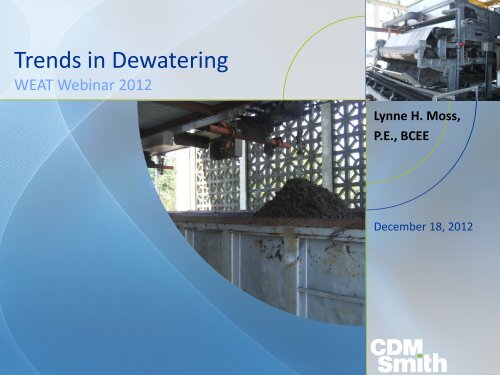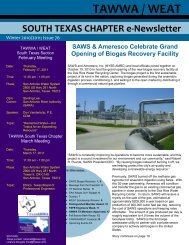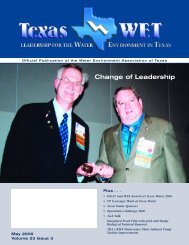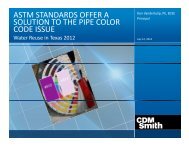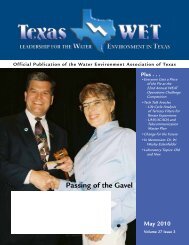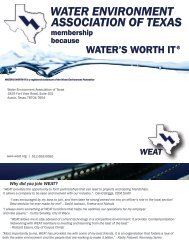Trends in Dewatering Technologies
Trends in Dewatering Technologies
Trends in Dewatering Technologies
You also want an ePaper? Increase the reach of your titles
YUMPU automatically turns print PDFs into web optimized ePapers that Google loves.
<strong>Trends</strong> <strong>in</strong> Dewater<strong>in</strong>gWEAT Web<strong>in</strong>ar 2012Lynne H. Moss,P.E., BCEEDecember 18, 2012
Overview• General drivers and trends• <strong>Technologies</strong>/case studies• Comprehensive pilot case study
Drivers for ChangeWorkforceChallenges• Reducedoperationalrequirements• ma<strong>in</strong>tenancesimplicityDewater<strong>in</strong>gTechnologyDriversEconomics• Increas<strong>in</strong>gdisposal/use costs• Labor costs• Energy costsOdorConcerns• Encloseddewater<strong>in</strong>g• Low shearprocesses
Level of UseDewater<strong>in</strong>g Technology EvolutionEstablishedInnovativeEmerg<strong>in</strong>gLabTestFailureTime• Established: ref<strong>in</strong>ements, not wholesale change• Innovative : <strong>in</strong>creas<strong>in</strong>g success <strong>in</strong> marketplace• Emerg<strong>in</strong>g : slow movement
Belt Filter Press <strong>Trends</strong>: 3- belt BFPs• Manufacturers:– Vertical: BDP, Charter Mach<strong>in</strong>e, Ashbrook– Horizonal: Ashbrook, Andritz, Koml<strong>in</strong>e• Designed for th<strong>in</strong> sludges (
Vertical 3-belt BFPSchematic Courtesy BDP
Horizontal 3-belt BFPINDEPENDENT GRAVITY ZONEHIGH PRESSURE ZONEWEDGE ZONESchematic Courtesy AshbrookBELT WASHSTATIONDEWATEREDSLUDGE
Reasons for 3-belt BFP Applications• Vertical units– Ease of access for ops/ma<strong>in</strong>tenance– Elim<strong>in</strong>ation of catwalks• Elim<strong>in</strong>ate need for additional BFP or thicken<strong>in</strong>g to accommodatehydraulic load• Potential 2-3% <strong>in</strong>crease <strong>in</strong> cake solids compared to 2-belts– Increase not limited to th<strong>in</strong> sludges
Case Study: Albany County Sewer District, NYNorth PlantLIQUIDS STREAM• Conventional activated sludge• Design/ADF flows = 35/25 mgdSouth PlantLIQUIDS STREAM• Conventional activated sludge• Design/ADF flows = 29/25 mgdSOLIDS HANDLING• 2.0m belt filter presses• Multiple hearth <strong>in</strong>c<strong>in</strong>erators (10hearths)• Operat<strong>in</strong>g 100 hrs/wk• Solids throughput = 1.5 DT/hr• Cake solids = 22%SOLIDS HANDLING• 1.5m belt filter presses• Multiple hearth <strong>in</strong>c<strong>in</strong>erators (7hearths)• Operat<strong>in</strong>g 65 hrs/wk• Solids throughput = 1.2 DT/hr• Cake solids = 19.8OBJECTIVE: INCREASE CAKE SOLIDS CONTENT
3- belt Press Installation at North Plant
North PlantNorth WWTP (2-m) South WWTP (1.5 m)
BFP Performance: Design vs ActualParameterUnitsNorth PlantSouth PlantDesign Actual Design ActualSize meter 2.0 1.5HydraulicThroughputDischargedDry SolidsDewateredCake SolidsSolidsRecoverygpm 100 to 200 152 75 to 150 132lbs/hrPolymer usage lb activepolymer/DT solids2,500 to3,0002,980 1,875 to2,2502,300MIN % 24 25.6 22 22.4% 95 98.9 95 98.210 6.4 10 6.4
New BFPs Have Less Payback < 4 YearsCake Solids Content (%)30252015102-Belt BFP3-Belt BFP50North PlantSouth PlantHigher cake solidsprovides $276,000/yrsav<strong>in</strong>gs.
Potential Future BFP <strong>Trends</strong>• Cont<strong>in</strong>ue to see 3-belts• Enclosed units for odorcontrol• Evolution to address“smooth sludges”– Larger roller(s) forgentle pressureCourtesy: Ashbrook
Centrifuge Dewater<strong>in</strong>g• Commonly used technology, especially at larger facilities– High throughput mach<strong>in</strong>e– Typically highest cake solids other than pressure filter• Uses centrifugal force to separate solids from liquids• Manufacturers: Alfa Laval, Andritz, Centrisys, Flotweg, Westfalia
Centrifuge Advantages and Disadvantages• Advantages– Small footpr<strong>in</strong>t, low staff<strong>in</strong>g requirements– Small, conta<strong>in</strong>ed odor source, facilitat<strong>in</strong>g odorcontrol– Major ma<strong>in</strong>tenance items easily removed/replaced• Disadvantages– High power consumption and polymer use– Relatively noisy, higher vibration• Vibration is a structural concern– High shear operation, result<strong>in</strong>g <strong>in</strong> higher odorpotential and possible <strong>in</strong>dicator regrowth– Expensive spare parts– Repair work performed by manufacturer
Centrifuges <strong>in</strong> Texas• Historically not dom<strong>in</strong>ant choice– Low disposal/use costs– Historic preference for BFPs– Historic ma<strong>in</strong>tenance requirements• Drivers mov<strong>in</strong>g <strong>in</strong> favorable direction– Disposal/use costs <strong>in</strong>creas<strong>in</strong>g– O&M somewhat simplified• Easy start up/shut down– Enclosed process (odors)• Concerns– Product odor– Regrowth/reactivation (AnD biosolids)
Centrifuge <strong>Trends</strong>• Focus on energyreduction (varies bymanufacturer)• Other– Controls – focus on “setit and forget it”– Interchangeable partsfor major ma<strong>in</strong>tenance(scrolls)• 4 hr vs multi-weekeffortSource: Alfa Laval (Islander),2012
Screw Press Dewater<strong>in</strong>g• Relatively new technology with grow<strong>in</strong>g <strong>in</strong>terest• From pulp/paper <strong>in</strong>dustry• Strong focus on west coast• Simple, low ma<strong>in</strong>tenance system• Free dra<strong>in</strong><strong>in</strong>g dewater<strong>in</strong>g device• Screw applies pressure aga<strong>in</strong>st basket• Potential cake solids expected slightly less than centrifuge• Manufacturers: FKC (horizontal), Huber (<strong>in</strong>cl<strong>in</strong>ed), PWTech(<strong>in</strong>cl<strong>in</strong>ed), BDP (<strong>in</strong>cl<strong>in</strong>ed)
Horizontal Screw PressCourtesy: FKC
Incl<strong>in</strong>ed Screw PressCourtesy: Huber
Screw Press Basket and Cake
Screw Press Advantages and DisadvantagesAdvantages• Enclosed system providesgood odor conta<strong>in</strong>ment• Easy start up and shut down,can run automated• Low power consumption• Low ma<strong>in</strong>tenancerequirementsDisadvantages• Low thoughput = more unitsand larger footpr<strong>in</strong>t• Typically, cake solids expectedto be lower than centrifuge• Typically, polymer doseexpected to be slightly higher• Test<strong>in</strong>g recommended
Rotary Press Features• Relatively “new” technology (to Texas)• Simple, best suited for raw sludges• Solids rotated between two parallelrevolv<strong>in</strong>g filter elements; filtrate flowsthrough these elements• Friction of plates and backpressureat outlet produces cake• Cake solids:• 25-28% P+WAS• 14-27% WAS• Manufacturers: Fournier, PrimeSolutions
Rotary Press OperationDra<strong>in</strong><strong>in</strong>gAreaSludge/PolymerFeedPress<strong>in</strong>gAreaSludge CakeFiltrateRestriction
Rotary Press- 6 Channel Unit
Rotary Press Advantages/Disadvantages• Advantages– Enclosed, lowodor, noise levels– Easily expanded– Small footpr<strong>in</strong>t– Easy start up,shut down– Ease of operation/ma<strong>in</strong>tenance– Low power consumption• Disadvantages– Works better with sludges that are more fibrous– Relatively small throughput; capital costs can be high
Case Study: Gloucester, MA (5 mgd Primary Plant)• Drivers– Labor requirements– Dewater<strong>in</strong>g roomodors– Washwaterrequirements• 2, 6-channel pressesParameterThroughputPerformance2,000 dry lb/hr (per 6-channel press)Cake solids 35-42%Dewater<strong>in</strong>g timeWashwater use6-12 hrs/week5 m<strong>in</strong>utes per day
Electrodewater<strong>in</strong>g• Suppliers : Ovivio C<strong>in</strong>etek, Siemens?• Add cathodes, anodes to pressurezone• Comb<strong>in</strong>ation of electro-osmosis andapplication of controlled mechanicalpressure to sludge– 500 to 1500 kwh/DT• Cake solids of 25-50%• Reported pathogen reduction• Canadian <strong>in</strong>stallations– Victoriaville: from ~15-18% to 35%– Valleyfield: from 14% to 25%
Electrodewater<strong>in</strong>g Advantages/DisadvantagesAdvantages• 40 to 50% reduction <strong>in</strong> sludgevolume, <strong>in</strong>creased solids• Small footpr<strong>in</strong>t• Reported pathogen and odorreduction• Self-conta<strong>in</strong>edDisadvantages• Few US vendors• Emerg<strong>in</strong>g technology• Relatively high powerconsumption• Needs high feed solids (10-20%)• Low throughput/high capital($1M+/meter)
Technology Comparison Case Study: Orange CountyUtilities, FL• Three facilities– Northwest WRF: 7.5 mgd– South WRF: 43 mgd, AnD– Eastern WRF: 24 mgd• General– No primary clarifiers– Different biological processes– Different biosolids process<strong>in</strong>g– Belt Filter Press Dewater<strong>in</strong>g
Feed Sludge CharacteristicsOCU Facility Solids Content Volatile Solids pHNorthwest WRF 1.0-1.5% 82-84% 7.0South WRF 3.0% 70-74% 7.5Eastern WRF 0.9-1.0% 88-90% 6.8
Pilot Test Results: Cake Solids ContentBelt FilterPressCentrifuge Screw Press Rotary FanPressNorthwest WRF 14% 23% 21% ---- 39%South WRF 13% 20% 17% 14% 37%Eastern WRF 15% 21% 20% 17% 43%Electro-Dewater<strong>in</strong>g
Polymer ConsumptionPounds ActivePolymer per TonCentrifugeScrewPressRotaryFan PressNorthwest WRF 20-24 18-20 ----South WRF 33-37 30-35 12-16Eastern WRF 19-23 18-24 12-16
Solids CapturePercent Capture Centrifuge Screw Press Electro-Dewater<strong>in</strong>gNorthwest WRF 97% 94% 92%South WRF 96% 95% 95%Eastern WRF 92% 97% 93%
Energy ConsumptionkWh per Ton Centrifuge Screw Press Electro-Dewater<strong>in</strong>gNorthwest WRF 98 14 225South WRF 53 6 265Eastern WRF 92 14 163
Implications for Orange County UtilitiesDry Tons per DayBelt Filter Press(WTPD)Centrifuge(WTPD)Northwest WRF 4.7 34 21 22South WRF 16.4 126 81 96Eastern WRF 19.7 131 96 97Total 40.8 291 198 215Screw Press(WTPD)
Conclusions• Dewater<strong>in</strong>g alternatives outperformed OCU’s BFPs• Screw press offers cake solids content comparable to centrifuge• L<strong>in</strong>ear electro-dewater<strong>in</strong>g, rotary press throughput too smallfor this application (multiple units needed)• Centrifuge selected due to high throughput and dewateredcake solids– Screw press preferred at one facility, but standardization was aconcern
Word of warn<strong>in</strong>g….Your results mayvary….When <strong>in</strong> doubt,pilot!!
Questions?


